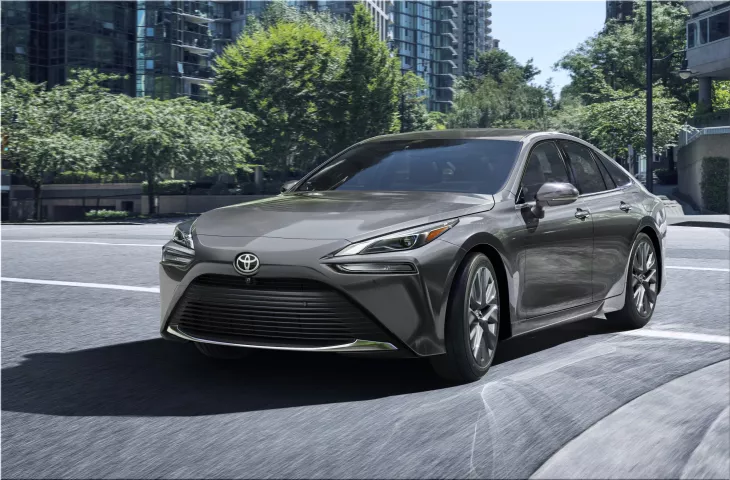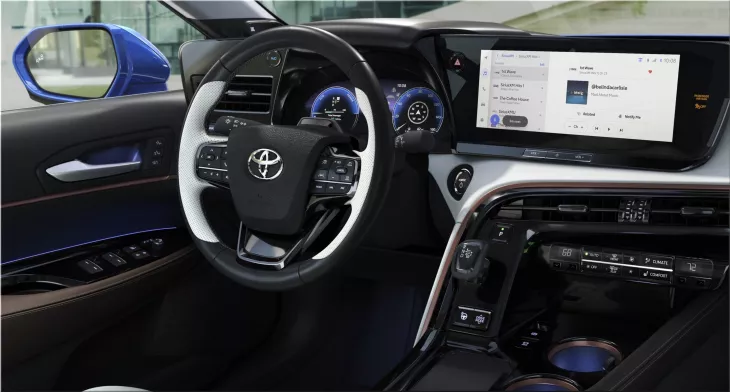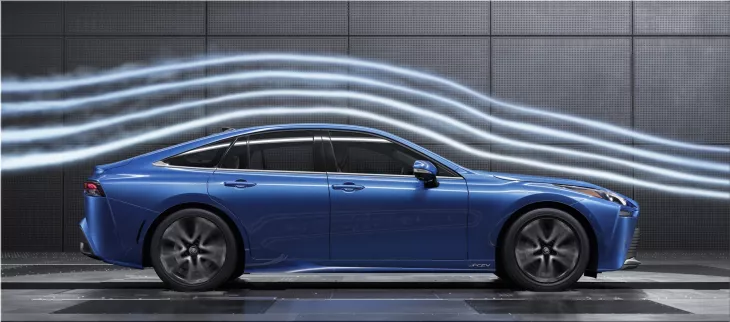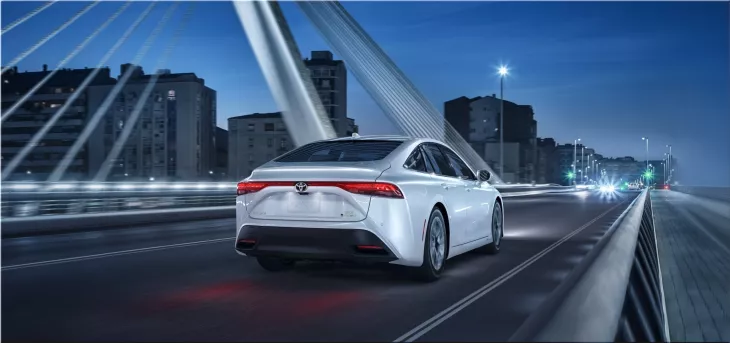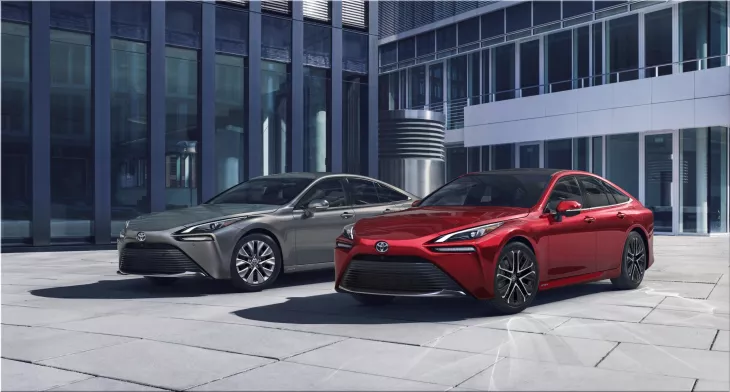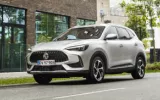Toyota has been a pioneer in the field of hydrogen fuel cell vehicles (FCEVs) since it launched the first-generation Mirai in 2015. The Mirai, which means “future” in Japanese, is a four-door sedan that runs on hydrogen-generated electricity. Unlike conventional electric vehicles (EVs) that need to be plugged in to recharge, the Mirai can be refueled in minutes at a hydrogen station and emits only water vapor from its tailpipe.
The Mirai has been praised for its long driving range, elegant design, and exotic car rarity. However, it has also faced challenges such as below-average power, poky acceleration, and limited availability. Only a few states in the US, mainly California, have the infrastructure to support FCEVs, and the Mirai’s high price tag ($51,000 for the base XLE trim and $68,000 for the Limited trim) has deterred many potential buyers.
However, Toyota is not giving up on its vision of a hydrogen-powered future. The company has recently unveiled the second-generation Mirai, which promises to improve significantly over its predecessor. The new Mirai, which will go on sale in 2024, features a more powerful and efficient fuel cell system, a more spacious and luxurious interior, and a more attractive and aerodynamic exterior. Toyota claims that the new Mirai will offer a more electrifying ride than ever before, and will appeal to a wider range of customers.
What’s New for the 2024 Toyota Mirai?
The 2024 Toyota Mirai is based on a new rear-wheel-drive platform that is shared with the Lexus LS and LC models. This platform allows for a lower and longer body, a wider stance, and a shorter overhang. The new Mirai is also 5.5 inches longer, 2.9 inches wider, and 2.4 inches lower than the previous model and has a 5.9-inch longer wheelbase. These dimensions give the new Mirai a more dynamic and sporty appearance and a more comfortable and spacious cabin.
The new Mirai also boasts a new fuel cell stack that is 30 percent smaller and lighter than the previous one but 50 percent more powerful. The new stack can produce up to 182 horsepower and 221 lb-ft of torque, compared to the previous model’s 151 horsepower and 247 lb-ft of torque. The new Mirai also has a larger hydrogen storage capacity, with three tanks that can hold up to 11.4 pounds of hydrogen, compared to the previous model’s two tanks that could hold up to 10.6 pounds. This means that the new Mirai can travel up to 402 miles on a single fill-up, according to the EPA, which is 30 miles more than the previous model.
The new Mirai also features a new 12.3-inch touchscreen infotainment system that supports Apple CarPlay, Android Auto, and Amazon Alexa. The system also includes a 14-speaker JBL sound system, a wireless charging pad, and a digital smartphone key. The new Mirai also has a full suite of driver-assistance features, such as adaptive cruise control, lane-keeping assist, blind-spot monitoring, rear cross-traffic alert, and automatic emergency braking. The new Mirai also offers a head-up display, a panoramic sunroof, and a digital rearview mirror as optional extras.
How Does the 2024 Toyota Mirai Compare to Its Rivals?
The 2024 Toyota Mirai is one of the few FCEVs available in the US market, along with the Hyundai Nexo and the upcoming Honda CR-V FCEV. The Nexo is a compact SUV that offers a 380-mile range, a 161-horsepower fuel cell system, and a $59,000 starting price. The Nexo also comes with a 12.3-inch touchscreen infotainment system, a blind-spot view monitor, and a remote smart parking assist feature. The CR-V FCEV is expected to debut in 2024 as well, and will be based on the popular CR-V crossover. The CR-V FCEV will likely offer a similar range and power as the Mirai but with a more spacious, versatile interior and lower price tag.
The Mirai also competes with conventional EVs, such as the Tesla Model 3 and the BMW 5 Series plug-in hybrid. The Model 3 is a compact sedan that offers a 353-mile range, a 346-horsepower electric motor, and a $40,630 starting price. The Model 3 also has a 15-inch touchscreen infotainment system, a full self-driving capability option, and a supercharging network. The 5 Series plug-in hybrid is a midsize sedan that offers a 30-mile electric range, a 288-horsepower hybrid system, and a $57,200 starting price. The 5 Series plug-in hybrid also comes with a 12.3-inch touchscreen infotainment system, a gesture control feature, and a luxurious interior.
What Are the Pros and Cons of the 2024 Toyota Mirai?
The 2024 Toyota Mirai has many advantages over its rivals, such as:
- Zero emissions: The Mirai only emits water vapor from its tailpipe, making it one of the cleanest vehicles on the road. The Mirai also uses hydrogen produced from renewable sources, such as solar, wind, and biogas, reducing its carbon footprint even further.
- Quick refueling: The Mirai can be refueled in minutes at a hydrogen station, compared to hours for an EV at a charging station. The Mirai also comes with a $15,000 fuel credit over three to six years, depending on whether you lease or purchase, and 21 days of complimentary vehicle rentals for when travel dictates drives away from areas with hydrogen fueling stations.
- Long range: The Mirai can travel up to 402 miles on a single fill-up, which is more than most EVs and hybrids. The Mirai also has a large trunk that can hold up to 14.4 cubic feet of cargo, which is not compromised by the hydrogen tanks or the battery pack.
- Luxurious and stylish: The Mirai has a sleek and sophisticated design that stands out. The Mirai also has a high-quality and spacious interior that features faux-leather upholstery, heated and power-adjustable seats, and ambient lighting. The Mirai also offers many advanced and convenient features, such as a head-up display, a panoramic sunroof, and a digital rearview mirror.
However, the 2024 Toyota Mirai also has some drawbacks, such as:
- Limited availability: The Mirai is only sold in a few states in the US, mainly California, where there are enough hydrogen stations to support FCEVs. The Mirai is also not eligible for the federal tax credit of up to $7,500 that applies to EVs and plug-in hybrids, although some states may offer their own incentives.
- High price: The Mirai is more expensive than most of its rivals, with a starting price of $51,000 for the base XLE trim and $68,000 for the Limited trim. The Mirai is also more costly to insure and maintain than conventional cars, due to its complex and rare technology.
- Low performance: The Mirai is not very fast or agile, compared to its rivals. The Mirai takes 9.1 seconds to reach 60 mph, which is slower than most EVs and hybrids. The Mirai also has modest handling and steering, which do not inspire much confidence or excitement.
Conclusion
The 2024 Toyota Mirai is a unique and innovative vehicle that offers a clean and comfortable alternative to conventional cars. The Mirai is powered by hydrogen, which produces electricity and water vapor and can be refueled in minutes. The Mirai also has a long-range, a luxurious interior, and a stylish exterior. However, the Mirai is also limited by its availability, high price, and low performance. The Mirai is a great choice for those who want to support the development of hydrogen fuel cell technology and reduce their environmental impact. Still, it may not be the best option for those who seek more practicality, affordability, and fun.





